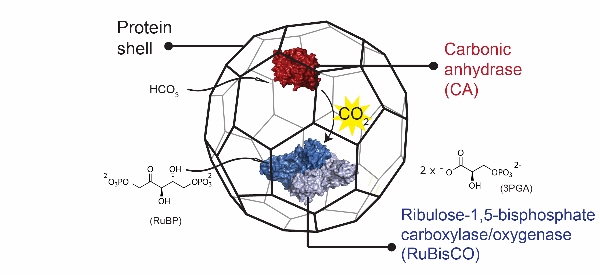Bottom-up construction of a primordial organelle
Several orthogonal bioreactions take place within membrane bound organelles in eukaryotes and proteinaceous microcompartments in bacteria. These subcellular structures contain sets of enzymes co-involved in metabolic pathways. Towards the goal of creating artificial protein microreactors, we have developed an artificial organelle that emulates the metabolic activity of the carbon fixating organelle of autotrophic bacteria, the carboxysome. Here, we show that the two key carboxysomal enzymes, ribulose-1,5-bisphosphate carboxylase/oxygenase (RuBisCO) and carbonic anhydrase (CA), can be efficiently co-encapsulated using our previously reported encapsulation system in a bacterial capsid formed from the protein lumazine synthase (AaLS-13). A statistically significant kinetic effect of co-encapsulated CA on RuBisCO activity was not observed under ambient or oxygen saturated conditions, suggesting that enzyme proximity alone may not be the key determinant in carboxysome function. The capsid shell protected the enzyme from proteolytic damage, however, a factor that could have provided early cyanobacteria with an evolutionary benefit. Our strategy to co-encapsulate different proteins can easily be extended to other sequentially acting enzymes and lays down principles for developing artificial organelles to control bio-synthetic pathways in vivo.

Shiksha Mantri, Raphael Frey, Marco Rocca, Donald Hilvert, JACS 2016